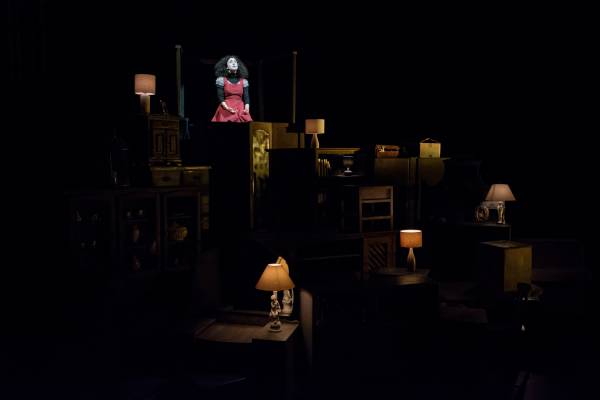Lennox Theatre, June 30
6/10

You see it in tantalising glimpses amid the dry ice, or peeking out from a nook in the mountain of furniture detritus: a pinched facial expression; a fluttering hand; a lost-girl voice; a furtive idea; a piece of self disembodied from the rest Aanisa Vylet’s character. In this labyrinth of ephemera lurks the real The Girl The Woman – the one where the stage is charged with electric possibilities, and we make our own connections.
Vylet spent 12 years developing the play (in which she also stars). That dogged determination to distil an idea is evident, as is an incomplete clarity about how best to do it. Even now it can feel we are privy to a process, because for the play to be refined to its ultimate potential required greater ruthlessness in understanding and amplifying what Vylet does best – which is to make her play dazzlingly theatrical. The closer it tiptoes to naturalism, the more cracks appear in the writing and acting. The truly exceptional phases, where Vylet and her play are both funniest and most moving, are often non-verbal, exploiting her skills as a mime, or her capacity to spear you on non-linguistic sounds.

The work is about a Muslim girl of Lebanese parentage transitioning to womanhood in Sydney and, later, London, and also about the travails of this character’s mother, played by Nisrine Amine. As both writer and actor Vylet is engaging and entertaining, with a sharp eye for absurdity and a deft one for satire, and her story fits the medium as snugly as a leotard. Yet somehow Vylet and director Dino Dimitriadis (for National Theatre of Parramatta) have still allowed flat, amateurish moments to compromise all that keenly-honed work.
Jonathan Hindmarsh’s ingenious set creates myriad perches and crannies where Vylet’s character can try on new and emerging concepts of self, much as she tries on shoes and make-up. To echo the theatricality the writing cries out for more of the poeticism present in a line like, “He has tattoos all over his breath” (said of an atheist for whom Vylet’s character falls), and perhaps that happens in the slabs of Arabic dialogue between mother and daughter.
A fine line lies between the modern curse of box-ticking theatre and a deeper inclusivity, and thankfully, amid its faults and flashes of brilliance, A Girl A Woman falls in the latter camp.